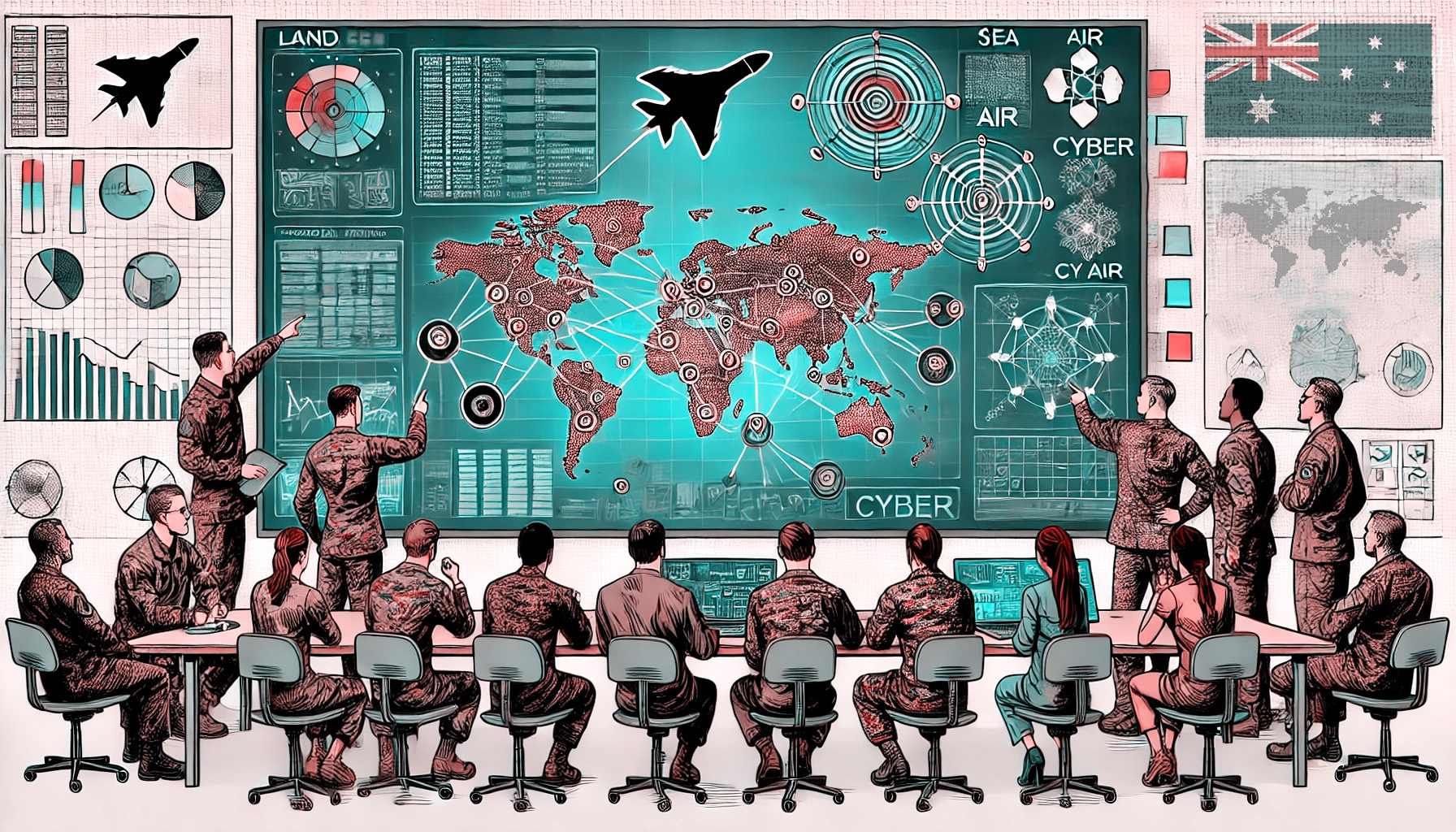Introduction
The Australian Defence Force’s updated approach to campaigning—encapsulated in its capstone doctrine, Integrated Campaigning,[1] and elaborated upon in Campaigns and Operations[2]—stands Defence in good stead to face the future challenges of complexity and resource constraints for three significant reasons, each with important caveats. First, the core concept of integration will prove essential in enabling Defence to tackle increasingly multifaceted and extensive operational demands—but it needs to be tempered by consideration of the costs and trade-offs of integration against its benefits. Second, the decisive shift from a paradigm of discrete, time-bound campaigns to ‘campaigning continuously’[3] will enable Defence to defend Australia’s interests against ever-present contestation. However, it remains unclear how the organisation will overcome the structural, resource, conceptual and ideological challenges of persistent campaigning. Third, the enduring ethos of reductionism and theoretical foundation of linear causality will be a double-edged sword that Defence can wield to cut through fog and friction in its complex future operating environment. Yet, its campaign doctrine and practice of operational art must do more to guard against predictable, convergent, linear thinking that cunning adversaries can exploit. Integrated campaigning, therefore, represents an important and significant stride in the right direction to meet the ADF’s future requirements, although it may prove an insufficient step should the above caveats be left untreated.
This paper will analyse each reason in the context of Australia as a middle power[4] faced with an increasingly complex security environment.[5] As a middle power, Australia must manage difficult trade-offs to advance a broad scope of national interests and maintain its geopolitical significance within its limited resource boundaries. Beyond securing its lengthy borders and maintaining heightened readiness amidst reduced strategic warning times,[6] Australia (often with Defence involvement) leads global efforts such as Antarctic protection,[7] and performs an outsized role in regional security and prosperity relative to its population and material capacity.[8] With these constraints, Australia confronts intense strategic competition in the Indo-Pacific region, characterised by intertwined diplomatic, economic, military and narrative dimensions.[9] Great power competition aside, Defence must also be prepared for lower-intensity regional contingencies stemming from natural disasters such as cyclones[10] (intensified by climate change),[11] and political instability in its near region, including Bougainville and West Papua.[12] This context clarifies the foundational assumptions implicit in Integrated Campaigning[13]and Campaigns and Operations[14] of what Australia’s near future will resemble and require of Australia. It thus provides the basis for analysing the applicability of the ADF’s approach to campaigning. Moreover, while these doctrinal documents belong to the ADF, ADF campaigns form the central cog of wider Defence efforts. This paper thus analyses the applicability of ADF doctrine to overall Defence effectiveness in the future environment.
Reaping the Benefits of Integration Without Ignoring Its Costs and Trade-Offs
The concept of integration—between domains,[15] instruments of national power,[16] and allies/partners[17]—is central to the ADF’s updated approach to campaigning,[18] and highly applicable in Defence’s operating context. It will be critical to tackling operational complexity within the volatile, uncertain, complex and ambiguous[19] strategic environment Defence will continue to face in the coming years. Complex modern operational challenges require inter-Service, inter-agency, international and public-private[20] collaboration to scope, frame and maximise options—an approach sometimes framed as a national security strategy[21] or total defence’.[22] Australia will need to apply not just military power but also other national instruments in the information, diplomatic and political economy spaces to maintain national security before, during and after conflict.[23] In the absence of a robust national security architecture,[24] integrated campaigning will pave the way for Defence to increasingly employ non-ADF levers (e.g. government, industry, civil society and international partners) complementarily, creating the legal, moral and narrative basis for ADF actions, especially when potential adversaries threaten national security with actions below the threshold of war.[25] Other Government Agencies (OGAs), particularly the Department of Foreign Affairs and Trade (DFAT), may also provide the entry point for the ADF into theatre, such as by securing a United Nations (UN) mandate for ADF insertion. This could be for civilian-led ‘complex emergency’ scenarios[26] or UN-mandated peace operations[27] like the 1999 Operation Warden[28] in East Timor. In the foreseeable future, potential flashpoints such as Bougainville could threaten regional stability should the domestic security situation deteriorate, or be exploited by external influences as proxy sites for strategic competition.[29] This makes integration essential for addressing the complex operational challenges that could consequently arise.
Integrated campaigning will also be essential for Defence due to Australia’s regional role vis-à-vis its resource constraints as a middle power. Australia has a wide range of interests and responsibilities in supporting and occasionally leading regional stability operations to maintain the rules-based global order.[30] However, its defence spending and Defence capacity may prove incommensurate with these ambitions should the military not be employed judiciously. Integrated campaigning can ease the resource tension by orchestrating military campaigns and other national or coalition efforts to achieve a sum effect greater than its parts. For example, at the national level, it provides a framework for regional security efforts that benefit Australia but cannot be sustained by the ADF alone. Integrated campaigns may emulate (in higher-intensity threat environments) how the Pacific Maritime Security Program (PMSP) paired Defence engagement with other forms of diplomacy. The PMSP enhanced not only maritime security in Australia’s adjacent waters but also inter-governmental interoperability with its Pacific neighbours,[31] which may form the foundation for future integrated campaigns against evolving threats. At the coalition level, integrated campaigning creates the impetus to influence (rather than passively accept, as in Afghanistan)[32] coalition strategy in service of national objectives. Integration will thus serve as a force multiplier to maximise the breadth and depth of Defence’s strategic effects within middle-power resource boundaries.
However, integrated campaigning currently fails to consider the costs and trade-offs of integration. It thus provides an incomplete picture of integration that may hamstring its future applicability for Defence. Unbounded integration is unrealistic and excessively costly—the profuse enthusiasm for integration across every conceivable capability, operation and entity in present doctrine[33] results in insufficient consideration of costs and trade-offs of each decision to integrate. Integration between ADF, OGAs and overseas partners will cost time and money. Creating technical, procedural and human interoperability requires capability development and integrated training, which cost must be weighed against the benefits of the attendant integration. Less evidently, integration will also often entail trade-offs in operational effectiveness, readiness and capacity. For example, even within the ADF, using common systems (e.g. communications system) between the Services may mean such systems are not optimised for environmental factors in each Service’s respective domain. Putting more integration training onto unit calendars will also mean less time for training core, specialised proficiencies. At the Whole-of-Government (WOG) level, conducting integrated planning for every scenario may slow down speed of response compared to single-agency response to a relatively straightforward problem. Integrating with Inter-Governmental Organisations (IGOs), Non-Governmental Organisations (NGOs) and OGAs will also require challenges of operational security, neutrality, and differing expectations[34] to be overcome. These costs and trade-offs will limit the utility of integrated campaigning if left unaccounted for.
The ADF’s approach to campaigning will therefore need to balance the costs and trade-offs of each decision to integrate against the benefits to its campaigns. Specifically, it must consider the three key questions of who to integrate with, when to integrate with them, and how to integrate under these circumstances. On the first question, integration within Defence and with external partners and allies must be considered. For example, while the integrated execution model of having the Chief of Joint Operations directly command all operations entrenches the doctrine and culture of integration,[35] it divorces force generation from force employment. This strengthens joint operational experience in subsequent operations[36] at the cost of synergies between training and operations, thus risking forces raised becoming unfit for purpose over time. Beyond Defence, Australia’s diversity of partners and allies[37] means integration with some may be at odds with integration with others, such as due to disparities in technological maturity or operating procedures. Deciding who to integrate with then drives consideration of when and how to integrate with chosen partners. For instance, Defence may need to consider whether it should prioritise integrating capabilities for high-end, large-scale conventional warfare with the US, and capabilities for low-intensity regional contingencies with South Pacific and Southeast Asian partners, rather than regard ever-expanding participation in multilateral exercises[38] as an unmitigated good. For integrated campaigning to be effective for Defence, it must not confuse developing strategic empathy and professional curiosity amongst a wide range of partners with diluting Defence capability and expertise to interoperate with everyone.[39]
Balancing Enduring Effect Against Finite Resource
After integration, the next most significant tenet of the ADF’s approach to campaigning is continuity. Like integration, the concept of campaigning continuously[40] will prove fundamentally pertinent to Defence as it is essential for Defence to uphold national interests in the ‘infinite game’ of geopolitics, in which Australia can only compete continuously as final victory does not exist.[41] While complex geopolitical problems such as stabilising a fragile state or dealing with strategic competition are not new, they will likely intensify in the Indo-Pacific region due to growing dissatisfaction with globalisation and mounting US-China contestation.[42] The attendant likelihood of increased military employment in more varied capacities[43] makes the ADF’s ability to campaign continuously especially important for its operational success. In the Regional Assistance Mission to Solomon Islands (RAMSI), the ADF participated in a 10-year campaign against relatively low-intensity threats, with a much-reduced military component after the first four months. In the coming years, threats to regional security could necessitate heavier ADF commitment for similarly long durations, and in some cases against better armed and organised adversaries than faced in RAMSI. Such threats could arise from instability in the less resilient Melanesian states like Vanuatu, the Solomon Islands or Papua New Guinea.[44] Further afield, Chinese military and paramilitary presence in the South China Sea looks set to continue expanding, which may necessitate a response involving Australian military assets.[45] The ability to campaign continuously in such scenarios would afford Defence the stamina to see through complex stabilisation missions or ‘grey zone contestations that are more likely than a clear peace-war duality in the foreseeable future.[46]
From the perspective of a middle power, continuous campaigning will also enable Defence to sustain a more persistent effect to secure long-term aims or succeed against long-lasting security challenges without having the ADF perpetually deployed. It allows efficient transition between Defence-led, Defence-supported and non-Defence campaigns so that costly military deployments can be scoped to achieve strategic objectives, then substituted for less costly means. For instance, naval/aerial assets and combat engineers may be used to enable access by humanitarian organisations to infrastructure-poor or unstable disaster zones before withdrawing once the latter’s presence has been established. This enables said components of Australia’s modestly sized military to be redeployed efficiently for other campaigns, or to preserve operational capacity for other contingencies.
However, the approach of campaigning continuously would be limited in application if organisational, resource and ideological challenges are not addressed as part of the approach. Defence will need to be organised and resourced to sustain continuous campaigning. It would otherwise overstretch its force employment capacity and be unable to meet force generation needs. To this end, its capstone doctrine focuses almost exclusively on the material factors needed to ‘sustain the fight’, advocating sovereign critical capabilities, adaptable logistics, and resilient supply chains.[47] It gives short shrift to human aspects of sustenance, considering only quantity (generating mass through mobilisation)[48] and not quality. This neglect of qualitative considerations, such as training needs and individual, team and organisational fatigue, inhibits the structural changes needed to sustain the organisation and not just the fight. For example, operational rotations must enable sufficient training and rejuvenation to sustain force competencies and morale, while mobilisation plans must account for individual currency and unit cohesion. Only then can a sufficiently robust concept of sustenance enable continuous campaigning to fulfil its lofty goals of ‘sustaining the application of national power [and] the continuous pursuit of national objectives’.[49]
In addition to organisational and resource challenges, continuous campaigning will also need to surmount significant ideological barriers to be effective. ADF commanders and planners have been drilled in the planning and execution of discrete, finite campaigns for decades. It will therefore be challenging to transform ‘episodic’[50] campaigning into consistent and continuous practice of operational art. The utility of continuous campaigning is contingent on campaign planners’ ability to adopt this radically different approach, seeing evolving objectives and lines of effort not as a failure of foresight in planning, but as a necessity[51] and even an advantage in complex, evolving environments. They will also need to understand when to terminate and launch new campaigns, an essential undertaking for which the updated doctrine does not conceptually equip them.[52] While it may be difficult to predict how adaptable Defence will be, it is instructive to examine the American experience since the US Joint Concept for Integrated Campaigning[53] was promulgated in 2018. Even five years after its release, the US Department ofDefense continues to be challenged by the inadequacy of intellectual tools to break out of limiting mental models, such as adopting an adversary-centric approach towards every problem.[54] Defence has made significant progress by discarding the traditional paradigm of ad hoc, disjointed campaigns that cannot tackle persistent contestation. However, its new approach to campaigning will only be effectively applied if doctrine revision is accompanied by organisational restructuring, education and mindset shifts.
Reconciling Convergent and Divergent Thinking
Finally, underlying the new keystone concepts of integration and continuity, the enduring ethos of reductionism and theoretical foundation of linear causality continue to underpin the ADF’s approach to campaigning. These form a double-edged sword for Defence to carry into future campaigns. On one hand, the easily applied heuristics that still characterise its updated doctrine can be wielded to cut through the fog and friction of war[55] and other operations. Such heuristics include the six steps of the campaign cycle,[56] prescriptions for determining lines of operations,[57] and use of the ‘centre of gravity’ concept.[58] Having them available for judicious use is necessary as fog and friction remain prevalent in modern operations, with little prospect of being eliminated in the near future.[59] Neither emerging technologies (e.g. artificial intelligence)[60] nor the latest operating concepts (e.g. information superiority’ or ‘decision superiority’)[61] have lived up to their promise of eradicating fog and friction. On the contrary, fog and friction may be intensified in the short and medium term as user understanding struggles to catch up with rapid technological advances[62]—in the case of campaigning, particularly at the senior leadership level.[63] Tools of reductionism and linear causality, therefore, enable the use of integrated campaigning in circumstances when the only alternative is impenetrable complexity. In such cases, they anchor the campaign against undesirable objective drift and help crystallise amorphous guidance that would otherwise be unable to unite Defence efforts amidst fog and friction.
On the other hand, over-reliance on (rather than judicious usage of) reductionism and linear causality results in predictable, convergent, deterministic thinking that is insufficient to handle a complex environment with cunning adversaries. The pervasive emphasis on linear lines of operation based on a cleanly ‘linked sequence of objectives’,[64] reliant upon predictability of ‘how a campaign is intended to unfold’,[65] culminating neatly in a ‘defeat mechanism’,[66] reveals a strong inclination towards the use of orderly, consistent frameworks to simplify and control operational complexity. It concentrates the application of operational art onto executing the plan rather than adapting faster than other actors. Dogmatically applied, such doctrine may produce tactical success at the cost of operational or strategic defeat by obscuring viable alternatives and overlooking dynamic ramifications in a complex environment.[67] The idea that the ‘campaign concept’ can be distilled to a ‘single, unifying idea’[68] similarly takes reductionism a step too far, forcing narrow approaches to wicked problems.[69] While Integrated Campaigning calls broadly for ‘unpredictable and asymmetric approaches’,[70] the rest of the doctrinal approach does not substantiate or support this aspiration. The ADF’s doctrine and practice must therefore do more to guard against predictability and groupthink, which its adversaries can exploit.
Consequently, the lack of alternative frameworks may considerably limit the applicability of the ADF’s method of campaign design and management. Campaigns and Operations’ one-track approach falls short in enabling ADF campaign designs to serve as dynamic ‘frameworks for action’, enabling rather than prescribing solutions[71] for their constituent operations. For example, the definitive culmination of a campaign in a ‘defeat mechanism’[72] sets up a zero-sum equation, which may not always be the necessary or preferred dynamic in modern conflicts. Campaign designers could instead consider an interests-based approach, framing a campaign as solving a shared problem instead of beating an adversary.[73] Other alternative frameworks might include design thinking[74] and the Cynefin framework.[75] The former’s emphasis on divergent methodologies would help realise Integrated Campaigning’saim of unpredictability, while the latter’s ‘probe-sense-response’ and ‘act-sense-response’ methods may respectively be better suited for complex and chaotic theatres encountered by Defence than an insatiable appetite for more information to reduce complex situations into neat analytical rubrics.[76] The ADF thus needs to expand its approach to campaigning to better define future problems and tackle complexity.
Furthermore, in implementation, the ADF’s updated approach to campaigning will need to contend against entrenched mindsets and years of professional military education (PME) premised on uniformity and reproducible, efficient outcomes. This inhibits the agility and innovation essential to creating new insights for a breakthrough approach like integrated campaigning to succeed.[77] The applicability of integrated campaigning is hence dependent on promoting nimble, novel practice of operational art throughout the campaign cycle. Campaign planners will need to generate original proposals instead of relying on past templates, while campaign commanders will need to be willing to venture beyond tried-and-tested avenues following staff recommendations. Unfortunately, the ADF’s longstanding predisposition towards ‘mechanistic, reductionist’ adherence to procedure at the operational level[78] is likely to pose a significant impediment to applying its new approach to campaigning. Beyond doctrine revision, institutional culture, leadership direction and PME pedagogy will need to change before integrated campaigning can be effectively applied in the coming years.
Conclusion
Given that both Integrated Campaigning and Campaigns and Operations were published this year, it is timely to examine whether they will enable Defence to succeed against upcoming challenges. This paper has established that the ADF’s updated doctrine on campaigning crystallises crucial concepts in preparing Defence for future complexity and constraints. Its core precepts of integration and continuity are vital paradigm shifts that will empower Defence to tackle the complexity of future operational challenges and reconcile Australia’s ambitious middle-power objectives with its limited means. Secondarily, its reductionist, linear methodology can help cut through otherwise impenetrable complexity if used judiciously. While these reasons are subject to significant caveats, the remaining deficiencies of the integrated campaigning approach are not insurmountable. Integrated campaigning will prove invaluable to Defence in its complex future environment with the costs and trade-offs of integration accounted for, the challenges of continuous campaigning mitigated, and the methodologies of campaign design expanded.
Existing literature has focused mainly on how the ADF should strengthen its operational art to connect military power to Australian strategic and grand strategic objectives,[79] and recover its competency in campaign planning.[80] That is a pedagogical question related to, but distinct from, the doctrinal question of whether the ADF’s approach to campaigning is effective and relevant. This paper has addressed the latter inquiry. With the issues identified in its findings resolved, integrated campaigning can enable Defence to become the vanguard of change for Australian government, industry and civil society to appreciate the complex challenge of ‘national defence’[81] for a middle power as a national effort, not just a Defence effort.
Ali, Irena; Bopping D, Hart D, Pascoe C & Warne L, ‘The Transition from Network-Centric Warfare to Networker-Centric Warfare: Outcomes of the Human Dimension of Future Warfighting Task’, DSTO Report No DSTO-CR-2007-0311 (Canberra: Defence Science and Technology Organisation, 2007).
Carr, Andrew, ‘Australia as a Middle Power’, in Australia’s Defence: Towards a New Era, edsPeter Dean, Brendan Taylor & Stephan Fruhling(Melbourne: Melbourne University Publishing, 2014).
–––, ‘Is Australia a Middle Power? A Systemic Impact Approach’, Australian Journal of International Affairs, Vol. 68, No. 1 (2014), pp 1-15.
Australian Bureau of Meteorology, State of the Climate 2022 (Canberra: The Commonwealth of Australia, 2022).
Australian Civil-Military Centre / Australian Council for International Development, Same Space – Different Mandates: A Civil-Military-Police Guide for Stakeholders in International Disaster and Conflict Response, rev. ed. (2023), https://www.acmc.gov.au/resources/publications/same-space-different-mandates-2023-edition (accessed 10 Oct 2023).
Australian Defence Force, ADF-P-3 Campaigns and Operations, 3rd ed. (Canberra: Defence Publishing Service, 2023).
–––, Integrated Campaigning: The Australian Defence Force’s Capstone Concept (Canberra: Defence Publishing Service, 2023).
–––, ADFP 5.0.1 Joint Military Appreciation Process, 2nd ed, AL3,(Canberra: Defence Publishing Service, 2019).
Bosio, Nick, ‘Integrated Campaigning – Part 1’, Australian Army Research Centre, 22 Mar 2022, https://researchcentre.army.gov.au/library/land-power-forum/integrated-campaigning-part-1 (accessed 10 Oct 2023).
–––, ‘Integrated Campaigning – Part 2’, Australian Army Research Centre, 5 Apr 2022, https://researchcentre.army.gov.au/library/land-power-forum/integrated-campaigning-part-2 (accessed 10 Oct 2023).
Clausewitz, Carl von, On War ed & trans Michael Howard and Peter Paret, (Princeton, NJ: Princeton University Press, 1976).
Crowther, Stephen, ‘Separatism in the South Pacific: From Bougainville to West Papua’, Institute for Security and Development Policy, 20 Dec 2019, https://www.isdp.eu/publication/separatism-in-the-south-pacific-from-bougainville-to-west-papua/ (accessed 28 May 2024).
Cullen, Ben, ‘Operation Southern Discovery: A JFAO Like No Other’, The Cove, 22 May 2018, https://cove.army.gov.au/article/operation-southern-discovery-jfao-no-other (accessed 11 Oct 2023).
Department of Defence, Defence Strategic Review (Canberra: Commonwealth of Australia, 2023).
Department of Defence, JDN 1-20 Information War: ADF Manoeuvre in the Information Environment (Canberra: Joint Doctrine Directorate, 2020).
Doane, Lawrence M, ‘Beyond Joint: The Need for an Interests-Centric Approach to Integrated Campaigning’, The Strategy Bridge, 30 Aug 2023,https://thestrategybridge.org/the-bridge/2023/8/30/beyond-joint-the-need-for-an-interests-centric-approach-to-integrated-campaigning (accessed 14 Oct 2023).
Ehlers Jr, Robert S & Blannin P, ‘Integrated Planning and Campaigning for Complex Problems’, U.S. Army War College Quarterly: Parameters, Vol. 51, No. 2 (2021), pp 97-109.
Evans, Michael, ‘The Closing of the Australian Military Mind: The ADF and Operational Art’, Security Challenges, Vol. 4, No. 2 (Winter 2008) pp 105-131.
Firth, Stewart, ‘Instability in the Pacific Islands: A Status Report’, Lowy Institute Fragile States Project, 4 Jun 2018, https://www.lowyinstitute.org/publications/instability-pacific-islands-status-report (accessed 13 Oct 2023).
Frank, Aaron B, ‘Building Strategies for Long-Term Competition: Infinite Games and Adaptive Planning’, in Adaptive Engagement for Undergoverned Spaces: Concepts, Challenges and Prospects for New Approaches (Santa Monica, CA: RAND Corporation, 2022), pp 141-178.
Hocking, Andrew, ‘Preparing for the Future: Key Organisational Lessons from the Afghanistan Campaign’, The Vanguard Occasional Paper Series, No. 2 (Mar 2022), pp 23, 32.
Horowitz, Michael & Kahn, Lauren, ‘The AI Literacy Gap Hobbling American Officialdom’, War on the Rocks, 14 Jan 2020, https://warontherocks.com/2020/01/the-ai-literacy-gap-hobbling-american-officialdom/ (accessed 15 Oct 2023).
Hughes, Zach, ‘Fog, Friction and Thinking Machines’, War on the Rocks, 11 Mar 2020,https://warontherocks.com/2020/03/fog-friction-and-thinking-machines/ (accessed 15 Oct 2023).
Joint Chiefs of Staff (JCS), Joint Concept for Integrated Campaigning (JCIC) (Washington, DC: JCS, 2018).
Jordaan, Eduard, ‘The Concept of a Middle Power in International Relations: Distinguishing Between Emerging and Traditional Middle Powers’, Politikon: South African Journal of Political Studies, Vol. 30, No. 1 (2003), pp 165-181.
Kramer, Franklin D, ‘Irregular Conflict and the Wicked Problem Dilemma: Strategies of Imperfection’, Prism, Vol. 2, No. 3 (06/2011), pp 75-100.
Lawrence, Calvin, ‘A Pathfinding Alternative to Centre-of-Gravity Based Learning’, The Forge, 2021,https://theforge.defence.gov.au/war-college-papers-2021/pathfinding-alternative-centre-gravity-based-learning (accessed 16 Oct 2023).
Lessard, Pierre, ‘Campaign Design for Winning the War and the Peace’, U.S. Army War College Quarterly: Parameters, Vol. 35, No. 2 (2005), pp 36-50.
Macdonald, Joshua, ‘Australia, China and Bougainville’s Choices’, The Diplomat, 21 Dec 2019, https://thediplomat.com/2019/12/australia-china-and-bougainvilles-choices/ (accessed 11 Oct 2023).
Marks, Thomas A & Ucko, David H, ‘Gray Zone in Red: China Revisits the Past,’ Small Wars and Insurgencies Journal, Vol. 32, No. 2 (2021), pp 181-204.
Marles, Richard, ‘Largest Ever Exercise Talisman Sabre to be Held in Australia’, Press Release, 16 Apr 2023, https://www.minister.defence.gov.au/media-releases/2023-04-16/largest-ever-exercise-talisman-sabre-be-held-australia (accessed 10 Oct 2023).
McKenna, Tim & McKay, Tim, “Australia’s Joint Approach: Past, Present and Future’, Joint Studies Paper Series, No. 1, (Canberra: Defence Publishing Service, 2017).
Monk, Jeremiah R, ‘End State: The Fallacy of Modern Military Planning’, PhD diss. (Maxwell, AL: Air War College, 2017).
Mori, Satoru, ‘Thinking About Long-Term Strategy in the South China Sea’, Asia Maritime Transparency Initiative, 13 Jan 2017, https://amti.csis.org/long-term-strategy-scs/ (accessed 13 Oct 2023).
Norwegian Ministry of Defence and Norwegian Ministry of Justice and Public Security, Support and Cooperation: A Description of Total Defence in Norway (Oslo: Norwegian Government Security and Service Organisation, 2018).
Paparone, Chris, ‘Designing Meaning in the Reflective Practice of National Security: Frame Awareness and Frame Reflection, in Design Thinking: Applications for the Australian Defence Force ed Aaron P Jackson(Canberra: Defence Publishing Service, 2019), pp.89-103.
Pietrucha, Mike, ‘Living with Fog and Friction: The Fallacy of Information Superiority’, War on the Rocks, 7 Jan 2016, https://warontherocks.com/2016/01/living-with-fog-and-friction-the-fallacy-of-information-superiority/ (accessed 15 Oct 2023).
Scott, Trent, The Lost Operational Art: Invigorating Campaigning into the Australian Defence Force (Canberra: Land Warfare Studies Centre Australia, 2011).
Smith, CR, Design and Planning of Operations in the Twenty-First Century (Canberra: Land Warfare Studies Centre, 2011).
Strating, Rebecca, ‘Strategy at Sea: A Plan B for Australia Maritime Security?’, Security Challenges, Vol. 16, No. 2 (2020), pp 58-70.
Tellis, Ashley J, Szalwinski, A & Wills M, Navigating Tumultuous Times in the Indo-Pacific (Washington, DC: National Bureau of Asian Research, 2022).
The White House, National Security Strategy 2022 (Washington, DC: The White House, 2022).
Tsoukas, Haridimos, ‘Noisy Organisations: Uncertainty, Complexity, Narrativity’, in Complex Knowledge: Studies in Organizational Epistemology (Oxford: Oxford University Press, 2005), pp 280-296.
Ury, William,; Fisher, Roger & Patton, Bruce, Getting to Yes: Negotiation Agreement Without Giving In, rev. ed.(New York, NY: Penguin Publishing Group, 2011).
Varrall, Merriden, ‘Australia’s Response to China in the Pacific: From Alert to Alarmed’, The China Alternative: Changing Regional Order in the Pacific Islands, eds Grame Smith & Terence Wesley-Smith, (Canberra: Australian National University Press, 2021), pp 107-141.
Votel, Joseph L. et al, ‘Unconventional Warfare in the Gray Zone’, Joint Force Quarterly, Vol. 80, No. 1 (1Q 2016), pp 101-109.
Wallace, Rodrick, Carl von Clausewitz, the Fog-of-War, and the AI Revolution: The Real World is not a Game of Go (Cham: Springer International Publishing AG, 2018).
Watts, Barry D, Clausewitzian Friction and Future War, rev. ed. (Washington, DC: Institute for National Strategic Studies, National Defence University, 2012).
Williams, Paul D & McDonald, Matt eds, Security Studies: An Introduction (Milton: Taylor & Francis Group, 2023).
Yarger, Harry R, Strategic Theory for the 21st Century (Carlisle, PA: U.S. Army War College Strategic Studies Institute, 2006).
Zweibelson, Ben, ‘One Piece at a Time: Why Linear Planning and Institutionalisms Promote Military Campaign Failures’, Defence Studies, Vol. 15, No. 4 (2015), pp 360-374.
1 Australian Defence Force, Integrated Campaigning: The Australian Defence Force’s Capstone Concept (Canberra: Defence Publishing Service, 2023).
2 Australian Defence Force, ADF-P-3 Campaigns and Operations, 3rd ed. (Canberra: Defence Publishing Service, 2023).
3 Ibid, p.17.
4 Andrew Carr, ‘Is Australia a Middle Power? A Systemic Impact Approach’, Australian Journal of International Affairs, Vol. 68, No. 1 (2014), p.1.
5 Paul D. Williams and Matt McDonald (eds), Security Studies: An Introduction (Milton: Taylor & Francis Group, 2023), pp 8-9.
6 Department of Defence, Defence Strategic Review (Canberra: Commonwealth of Australia, 2023), p24.
7 Ben Cullen, ‘Operation Southern Discovery: A JFAO Like No Other’, The Cove, 22 May 2018,https://cove.army.gov.au/article/operation-southern-discovery-jfao-no-other (accessed 11 Oct 2023).
8 Andrew Carr, ‘Australia as a Middle Power’, in Australia’s Defence: Towards a New Era? eds Peter Dean, Brendan Taylor and Stephan Fruhling, (Melbourne: Melbourne University Publishing, 2014), p 47.
9 Department of Defence, Defence Strategic Review, p 5.
10 Ibid, pp 41-42.
11 Australian Bureau of Meteorology, State of the Climate 2022 (Canberra: The Commonwealth of Australia, 2022), p 25.
12 Stephen Crowther, ‘Separatism in the South Pacific: From Bougainville to West Papua’, Institute for Security and Development Policy, 20 Dec 2019,https://isdp.eu/content/uploads/2019/12/Separatism-in-the-South-Pacific-20.12.19-Final.pdf (accessed 11 Oct 2023), p 4.
13 Australian Defence Force, Integrated Campaigning, pp 1-2 (“Introduction”).
14 Australian Defence Force, Campaigns and Operations, pp 2-3 (“Strategic Context”).
15 Australian Defence Force, Integrated Campaigning, pp 8, 20; Campaigns and Operations, p 36.
16 Australian Defence Force, Integrated Campaigning, pp 8-9; Campaigns and Operations, p 7.
17 Australian Defence Force, Integrated Campaigning, pp 8-9; Campaigns and Operations, p 56.
18 Australian Defence Force, Integrated Campaigning, pp 3-4.
19 Harry R. Yarger, Strategic Theory for the 21st Century (Carlisle, PA: U.S. Army War College Strategic Studies Institute, 2006), p 17.
20 c.f. Department of Defence, Defence Strategic Review, pp 77, 81-82 on strategic industrial policy for fuel security.
21 For example, The White House, National Security Strategy 2022 (Washington, DC: The White House, 2022).
22 For example, Norwegian Ministry of Defence and Norwegian Ministry of Justice and Public Security, Support and Cooperation: A Description of Total Defence in Norway (Oslo: Norwegian Government Security and Service Organisation, 2018).
23 Nick Bosio, ‘Integrated Campaigning – Part 1’, Australian Army Research Centre, 22 Mar 2022,https://researchcentre.army.gov.au/library/land-power-forum/integrated-campaigning-part-1 (accessed 10 Oct 2023).
24 Department of Defence, JDN 1-20 Information War: ADF Manoeuvre in the Information Environment (Canberra: Joint Doctrine Directorate, 2020), para 5.21.
25 Thomas A. Marks and David H. Ucko, ‘Gray Zone in Red: China Revisits the Past’, Small Wars and Insurgencies Journal, Vol. 32, No. 2 (2021), p 181.
26 Australian Civil-Military Centre / Australian Council for International Development, Same Space – Different Mandates: A Civil-Military-Police Guide for Stakeholders in International Disaster and Conflict Response, rev. ed. (2023), https://www.acmc.gov.au/resources/publications/same-space-different-mandates-2023-edition (accessed 10 Oct 2023), p 31.
27 Ibid, pp 83-84. These include conflict prevention, peace-making, peacekeeping, peace enforcement and peace-building, with different levels of military involvement.
28 Operation Warden was the ADF-led deployment of International Force East Timor (INTERFET) for peacekeeping and humanitarian assistance in East Timor in 1999.
29 Joshua Macdonald, ‘Australia, China and Bougainville’s Choices’, The Diplomat, 21 Dec 2019, https://thediplomat.com/2019/12/australia-china-and-bougainvilles-choices/ (accessed 11 Oct 2023).
30 Eduard Jordaan, ‘The Concept of a Middle Power in International Relations: Distinguishing Between Emerging and Traditional Middle Powers’, Politikon: South African Journal of Political Studies, Vol. 30, No. 1 (2003), pp 166-167.
31 Rebecca Strating, ‘Strategy at Sea: A Plan B for Australia Maritime Security?’, Security Challenges, Vol. 16, No. 2 (2020), p 67.
32 Andrew Hocking, ‘Preparing for the Future: Key Organisational Lessons from the Afghanistan Campaign’, The Vanguard Occasional Paper Series, No. 2 (Mar 2022), pp 23, 32.
33 Australian Defence Force, Integrated Campaigning, p 4.
34 Australian Civil-Military Centre, Same Space – Different Mandates, p 73.
35 Tim McKenna and Tim McKay, ‘Australia’s Joint Approach: Past, Present and Future’, Joint Studies Paper Series, No. 1, (Canberra: Defence Publishing Service, 2017), p 9.
36 Irena Ali, Derek Bopping, Dennis Hart, Celina Pascoe and Leonie Warne, ‘The Transition from Network-Centric Warfare to Networker-Centric Warfare: Outcomes of the Human Dimension of Future Warfighting Task’, DSTO Report No DSTO-CR-2007-0311 (Canberra: Defence Science and Technology Organisation, 2007), para 3.4.5.
37 Australian Defence Force, Campaigns and Operations, pp 6-8, 57.
38 e.g. Richard Marles, ‘Largest Ever Exercise Talisman Sabre to be Held in Australia’, Press Release, 16 Apr 2023,https://www.minister.defence.gov.au/media-releases/2023-04-16/largest-ever-exercise-talisman-sabre-be-held-australia (accessed 10 Oct 2023).
39 Nick Bosio, ‘Integrated Campaigning – Part 2’, Australian Army Research Centre, 5 Apr 2022,https://researchcentre.army.gov.au/library/land-power-forum/integrated-campaigning-part-2 (accessed 10 Oct 2023).
40 Australian Defence Force, Campaigns and Operations, p 17.
41 Aaron B. Frank, ‘Building Strategies for Long-Term Competition: Infinite Games and Adaptive Planning’, in Adaptive Engagement for Undergoverned Spaces: Concepts, Challenges and Prospects for New Approaches, eds Aaron B. Frank and Elizabeth M. Bartels(Santa Monica, CA: RAND Corporation, 2022), pp 145-146, 149-150.
42 Ashley J. Tellis, Alison Szalwinski and Michael Wills, Navigating Tumultuous Times in the Indo-Pacific (Washington, DC: National Bureau of Asian Research, 2022), pp 6-7.
43 Merriden Varrall, ‘Australia’s Response to China in the Pacific: From Alert to Alarmed’, in The China Alternative: Changing Regional Order in the Pacific Islands, edsGrame Smith and Terence Wesley-Smith, (Canberra: Australian National University Press, 2021), pp 125-126.
44 Stewart Firth, ‘Instability in the Pacific Islands: A Status Report’, Lowy Institute Fragile States Project, 4 Jun 2018, https://www.lowyinstitute.org/publications/instability-pacific-islands-status-report (accessed 13 Oct 2023).
45 Satoru Mori, ‘Thinking About Long-Term Strategy in the South China Sea’, Asia Maritime Transparency Initiative, 13 Jan 2017, https://amti.csis.org/long-term-strategy-scs/ (accessed 13 Oct 2023).
46 Joseph L. Votel et al, ‘Unconventional Warfare in the Gray Zone’, Joint Force Quarterly, Vol. 80, No. 1 (1Q 2016), p 102.
47 Australian Defence Force, Integrated Campaigning, pp 23-24.
48 Ibid, pp 24-25.
49 Ibid, p 23.
50 Robert S. Ehlers Jr and Patrick Blannin, ‘Integrated Planning and Campaigning for Complex Problems’, U.S. Army War College Quarterly: Parameters, Vol. 51, No. 2 (2021), p 101.
51 Pierre Lessard, ‘Campaign Design for Winning the War and the Peace’, U.S. Army War College Quarterly: Parameters, Vol. 35, No. 2 (2005), p 42.
52 Campaigns and Operations proceeds through the logical order of situational understanding (Chapter 5), planning (Chapter 6), preparation (Chapter 7), execution (Chapter 8) and campaign management (Chapter 9, the final chapter), only to stop short of explaining when and how to conclude a campaign.
53 Joint Chiefs of Staff (JCS), Joint Concept for Integrated Campaigning (JCIC) (Washington, DC: JCS, 2018).
54 Lawrence M. Doane, ‘Beyond Joint: The Need for an Interests-Centric Approach to Integrated Campaigning’, The Strategy Bridge, 30 Aug 2023, https://thestrategybridge.org/the-bridge/2023/8/30/beyond-joint-the-need-for-an-interests-centric-approach-to-integrated-campaigning (accessed 14 Oct 2023).
55 Carl von Clausewitz, On War, ed & trans Michael Howard and Peter Paret, (Princeton, NJ: Princeton University Press, 1976), Book 1 Ch. 8 & Ch. 3 respectively.
56 Australian Defence Force, Campaigns and Operations, pp 14-17.
57 Ibid, pp 80-83.
58 Ibid, pp 23, 74.
59 Barry D. Watts, Clausewitzian Friction and Future War, rev. ed. (Washington, DC: Institute for National Strategic Studies, National Defence University, 2012), pp 79-84.
60 Rodrick Wallace, Carl von Clausewitz, the Fog-of-War, and the AI Revolution: The Real World is not a Game of Go (Cham: Springer International Publishing AG, 2018), p 91.
61 Mike Pietrucha, ‘Living with Fog and Friction: The Fallacy of Information Superiority’, War on the Rocks, 7 Jan 2016, https://warontherocks.com/2016/01/living-with-fog-and-friction-the-fallacy-of-information-superiority/ (accessed 15 Oct 2023).
62 Zach Hughes, “’Fog, Friction and Thinking Machines’, War on the Rocks, 11 Mar 2020,https://warontherocks.com/2020/03/fog-friction-and-thinking-machines/ (accessed 15 Oct 2023).
63 Michael Horowitz and Lauren Kahn, ‘The AI Literacy Gap Hobbling American Officialdom’, War on the Rocks, 14 Jan 2020, https://warontherocks.com/2020/01/the-ai-literacy-gap-hobbling-american-officialdom/ (accessed 15 Oct 2023) – while commenting on US national security challenges, is also relevant to the similar Defence context.
64 Australian Defence Force, Campaigns and Operations, p 71.
65 Ibid, p 76.
66 Ibid, pp 74, 76.
67 Jeremiah R. Monk, ‘End State: The Fallacy of Modern Military Planning’, PhD diss. (Maxwell, AL: Air War College, 2017), pp 7-8.
68 Australian Defence Force, Campaigns and Operations, p 78.
69 Franklin D. Kramer, ‘Irregular Conflict and the Wicked Problem Dilemma: Strategies of Imperfection’, Prism, Vol. 2, No. 3 (06/2011), p 82.
70 Australian Defence Force, Integrated Campaigning, p 22.
71 CR Smith, Design and Planning of Operations in the Twenty-First Century (Canberra: Land Warfare Studies Centre, 2011), p 75. In contrast, ADF doctrine implicitly adopts the same approach to planning operations and campaigns – see Australian Defence Force, ADFP 5.0.1 Joint Military Appreciation Process, 2nd ed., AL3,(Canberra: Defence Publishing Service, 2019), p iii.
72 Australian Defence Force, Campaigns and Operations, pp 74, 76.
73 c.f. William Ury, Roger Fisher and Bruce Patton, Getting to Yes: Negotiation Agreement Without Giving In, rev. ed.(New York, NY: Penguin Publishing Group, 2011), pp 23ff.
74 Chris Paparone, ‘Designing Meaning in the Reflective Practice of National Security: Frame Awareness and Frame Reflection’, Design Thinking: Applications for the Australian Defence Force, ed Aaron P. Jackson,(Canberra: Defence Publishing Service, 2019), p 97.
75 Calvin Lawrence, ‘A Pathfinding Alternative to Centre-of-Gravity Based Learning’, The Forge, 2021,https://theforge.defence.gov.au/node/612 (accessed 16 Oct 2023).
76 Haridimos Tsoukas, ‘Noisy Organisations: Uncertainty, Complexity, Narrativity’, in Complex Knowledge: Studies in Organizational Epistemology (Oxford: Oxford University Press, 2005), p.293.
77 Ben Zweibelson, ‘One Piece at a Time: Why Linear Planning and Institutionalisms Promote Military Campaign Failures’, Defence Studies, Vol. 15, No. 4 (2015), p 362.
78 Scott, The Lost Operational Art, pp 100.
79 Michael Evans, ‘The Closing of the Australian Military Mind: The ADF and Operational Art’, Security Challenges, Vol. 4, No. 2 (Winter 2008) pp 106, 124.
80 Trent Scott, The Lost Operational Art: Invigorating Campaigning into the Australian Defence Force (Canberra: Land Warfare Studies Centre Australia, 2011), pp 3-4.
81 Department of Defence, Defence Strategic Review, pp 3 1ff.









Comments
Start the conversation by sharing your thoughts! Please login to comment. If you don't yet have an account registration is quick and easy.